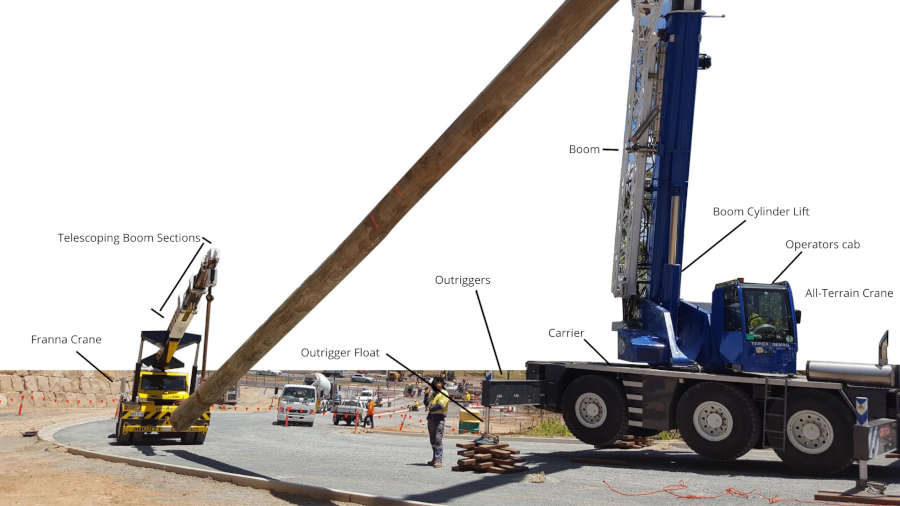
Carrier
The carrier is the area of the crane that sits below the turntable bearing.
Operators cab
The operator’s cab is where the crane operator sits when maneuvering the crane during lifts.
Outrigger
The outrigger is a beam used to stabilise a mobile crane during a stationary lift. Outriggers are deployed when the carrier is in place and come out from the side of the crane to increase the surface area improving stability.
Outrigger float or jack
The outrigger float is a hydraulic cylinder attached to the end of the outrigger beam. It extends to raise the crane and increase the cranes surface area to improve stability while lifting. The outriggers are also used to create a level lifting platform for the crane.
Counterweight
Counterweights are found on the back of the crane. The job of a counterweight is to stop the crane from tipping during a lift. A counterweight in its basic definition exerts an opposite force to provide balance and stability.
Wire Rope
The wire rope is the cable that cranes use to lift loads. They are made of twisted steel wires.
Hoist
The hoist is a mechanical device that lifts and lowers the attached load by extending and retracting the wire rope.
Boom
The boom is probably the most identifiable section of a crane to the everyday person. It is the arm that extends from the crane, including the hydraulic telescoping sections.
Boom hoist or Cylinder Lift
The boom Cylinder Lift is a hydraulic lift that controls the angle of the crane boom and counteracts the downward force during the lift.
Load
The load is the total weight superimposed on the hoist load block or hook.
Load block
The load block is where the load is attached to the crane. Load blocks include the assembly of the hook/shackle, swivel, bearing, sheaves, sprockets, pins and suspended by the wire rope.
Franna Pick And Carry / Taxi Cranes
The Franna crane, is a pick and carry crane also known as a taxi crane as it can lift and taxi its load around the job site. The Franna crane was developed in Australia in 1980 and has dominated the pick and carry market. Most pick and carry cranes today are knows as Franna cranes due to their popularity. Franna cranes are roadworthy vehicles and can drive on public roads.
All-Terrain Cranes
All-Terrain cranes are a combination of a truck and a mobile crane. They often have been 6-8 tyres but can have much more and featuring all-wheel or four-wheel drive giving them the ability to drive on sand and loose surfaces. All-Terrain Cranes are road-worthy cranes and can drive on public roads.
Rough Terrain Cranes
Rough Terrain Cranes have four large tyres that make it capable of climbing over a variety of rough terrain. Some Rough Terrain Cranes can switch between 2-wheel and 4-wheel drive to switch between on and off-road access.
City Cranes
City cranes have a carrier with a small footprint, an adjustable turning circle and a telescopic boom which makes them an excellent option for domestic and commercial tight access job sites.

